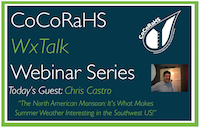|

Webinar #41 - Thursday, October 15, 2015
The North American Monsoon: It's What Makes Summer Weather Interesting in the Southwestern United States!
Christopher L. Castro
Associate Professor, Department of Atmospheric Sciences
University of Arizona
Tucson, AZ

(biography)
The North American
monsoon is the period of rainfall and severe weather that occurs during
the mid to late part of the summer in the Southwestern United States.
The basic cause of the North American monsoon, like its cousin in India,
is the thermal contrast between the land and ocean. Though certainly
not as dramatic as India, the North American monsoon is associated with
regular shifts in circulations, winds, and precipitation. Monsoon
thunderstorms are initiated by mountain-valley circulations and follow a
regular diurnal cycle. The most dramatic severe weather days are
characterized by organized, propagating convection in association with
upper-level disturbances. Severe weather hazards during the monsoon
unique to the Southwest include flash flooding, debris flows,
micro-bursts, haboobs (or dust storms), lightning, and wildfire.
Predictability of the monsoon is challenging, even for daily weather
forecasts. High resolution numerical atmospheric models are required to
explicitly resolve monsoon thunderstorms, and even the most
sophisticated modeling tools will never be able to tell us with
certainty if when and where storms will occur at an exact location.
When thinking on longer timescales, there are some potential predictable
factors which may govern monsoon seasonal rainfall, especially during
the onset period. Monsoon precipitation is also likely changing in
relation to anthropogenic climate change, with the changes generally
conforming to a "wet gets wetter, dry gets drier" paradigm that is
observed globally.

View the Webinar by clicking here: https://youtu.be/KOwqokePMbE
View Chris' presentation slides  (8MB) (8MB)
Resources:
CLIMAS (Climate Assessment for the Southwest)
|